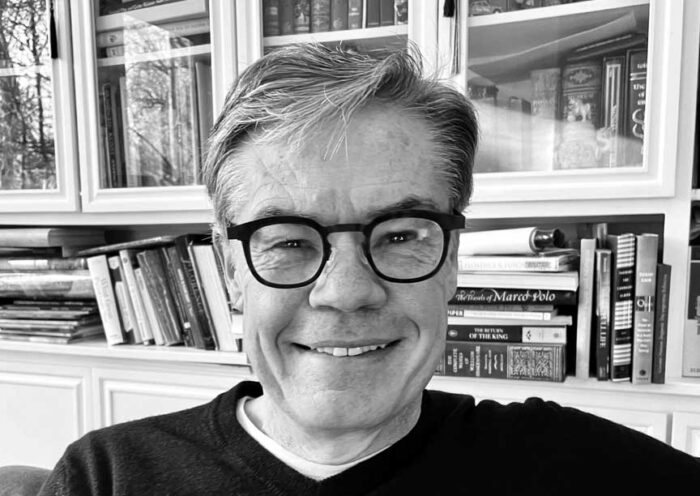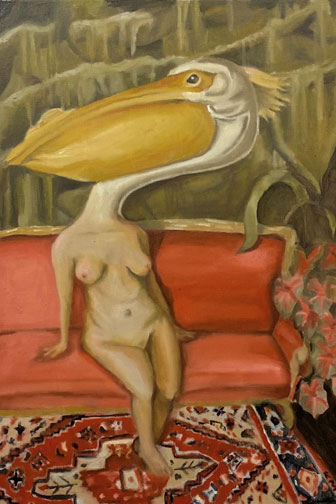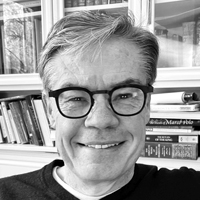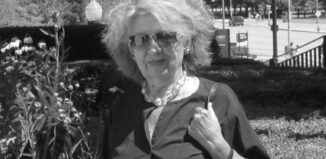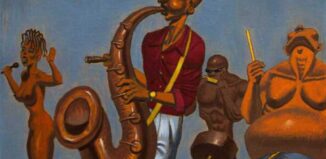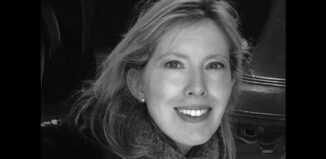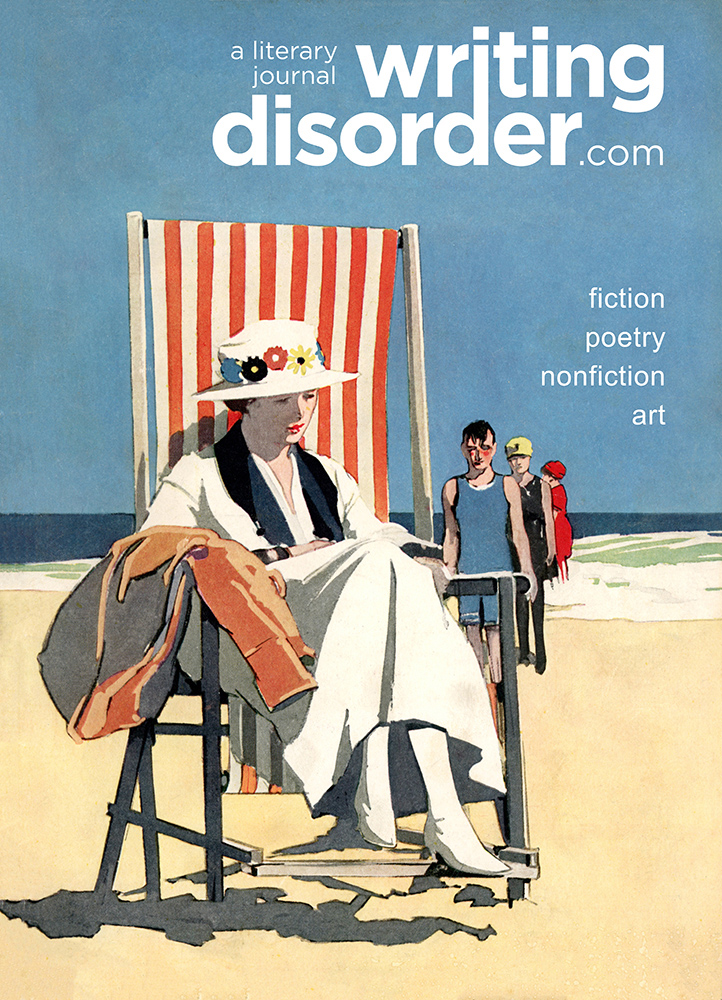Self Portrait by the Thing Within
by Clayton McMillan
Metamorphosis Phase II, Oil on Canvas 2023, Katja McMillan
There were gasps and even some laughter at the unveiling of Paula’s painting, and although she stood within arm’s length, she could barely make out the details of what she had created. This response was not what she had planned. She felt a sense of drowning.
Paula had had a following in the avant-garde art scene in Hamburg in the early 1920s, particularly among the expressionists. It was the Weimar Republic, Germany’s fledgling experiment with democracy following the humiliation of the Treaty of Versailles. At the exhibitions of the artist group the Hamburg Secession, of which she was a member, patrons surrounded her in the back room where her work was on display, and marveled at her excellent German as she answered questions about growing up on the vast expanses of the Kansas prairie.
“What are the Indians like there?” someone asked.
“They are long gone,” she replied.
“Where did you learn to speak German?”
“I’ve lived in Germany for five years. What do you think of my paintings?” she prompted.
Ignoring her question they replied, “Do the buffalo herds really number in the thousands?”
“They are long gone.”
“Do you have any buffalo paintings?”
When Paula had first arrived in Germany at age 23, she made friends with a group of young Germans also trying to break into the art scene. In the art museum, the Hamburg Kunsthalle, she marveled at the broad post-impressionistic brushstrokes in Pierre Bonnard’s Evening at the Uhlenhorster Ferry House. Hamburg was a wealthy port city, with beautiful tree lined boulevards and two sweeping lakes, the Innenalster and Außenalster, whose shores were lined with the villas of the wealthy and with foreign consulates. When she learned that Bonnard’s painting depicted an actual place in Hamburg, she asked her friends to take her there.
On the day of the outing, the water was crowded with sailboats, as in the painting. A surprise gust of wind caused several boats to capsize, throwing Paula headfirst into the water. Disoriented, she panicked, she was a poor swimmer, and the weight of her wet clothing pulled her down. In the opaque murkiness there were vague shapes and then the light of the surface above. She swam towards it: a chaos of kicking limbs and swirling ores and masts and sails and boat hulls, and many other boaters in the water. The men, being the stronger, pushed past her. Paula was kicked in the face and several times she was pushed down by the feet of those above her as if her head were a steppingstone. It was her nature to let others go first and later she realized that was a mistake. Each time she rose she was pushed down. Finally, when she felt she would surely drown she broke to the surface gasping ferociously for air. It was a traumatic incident which led to a suffocating darkness in her paintings. She vowed never again. She replayed it in her mind, but the other way around, with her rising quickly to the surface by stepping on the others, and this reversal helped the trauma subside. By the time she joined the Hamburg Secession she had put it behind her and adopted a brighter style consistent with the other artists.
Rumors circulated that Otto Fischer Trachau, the expressionist painter, interior architect, and founding member of the Hamburg Secession had taken her as his lover. They were seen together often, in the bars and restaurants of the Reeperbahn or strolling through Hagenbeck’s Tierpark, the luxurious and extensive park-like zoo in Hamburg. He was 15 years her senior.
Paula was fond of animals as artistic subject matter. Strolling through the gardens of Hagenbeck’s, beneath the lush weeping willows that drooped over the edges of the two expansive ponds shading a waddle of sleeping ducks, past the vivid, abundant flower beds, they would stop at one animal pen or another. Trachau would school her in the appropriate German, “ein Rudel Löwen” for “a pride of lions” or, he would explain animal behaviors in the way that smart men talk to women.
“Pelicans fly several meters above the surface,” he once tutored her. “When they see a school of fish, they fold their wings and drop like a stone into the water, filling the pouch beneath their beaks. They consume as many as they can at once, swallowing them whole. It’s gluttony.”
“Fascinating,” said Paula. The subtle sarcasm in her voice went unnoticed.
Trachau continued, “Because of their excellent eyesight they thrive, but ironically, they go permanently blind at the constant impact. Without eyesight they cannot see the fish and they starve to death.”
Paula did nothing to quell the rumors, which went on for years, of the affair. The art world was competitive and being seen with Trachau led enthusiasts to assume her work must be good. She was getting noticed. One of her paintings was featured in a local art rag. She was referred to as the “female Trachau,” which made her seethe. She had developed her own unique style and anybody with training could see that it was not a copy of Trachau’s. But she simply nodded politely and observed, “He’s a great artist. I take that as a compliment.”
At the exhibitions and in smaller gallery shows Paula started wearing a tuxedo and smoking a cigar. In her youth she was stunning. The dark fabric of the jacket and the silky black bowtie accentuated her cascading blond hair, which she held back with a glittering headband. The red lipstick she wore encircled the cigar like a tight-fitting ring as she inhaled, and emphasized the shape of the smoke rings she could blow with perfection, one after another, until she smacked her lips shut again, slipping into a coy grin. She was featured in the mainstream daily, the Hamburger Anzeiger and its weekly supplement, Das Reich der Frau (The Realm of Woman) as simply “the American”. The appropriateness of her attire, if not her art, was discussed at length. It had not been easy to break in and it was not easy to stay in, as a foreigner, and especially as a woman. Each time she rose she was pushed down. She learned to run with the boys. She was often in the bars in the red-light district smoking and drinking with the male artists till the wee hours of the morning. She carried a palm sized derringer in her purse for when she had to walk home after the last tram.
In 1929 Paula was offered a position as a lecturer at the St. Georg Kunstakademie, an unusual honor for a woman. She had just turned 32. Even though she had lived in Germany for years, she had not lost her American self-assurance that was foreign to staid German culture. She moved through space with a sense that she owned it and was forgiven for regular social transgressions because she was American and thus wouldn’t know any better. Young artists, especially the few that were women, were drawn to her cocky but seemingly kind approach to everything, whether it be dealing with the director, with the male artists, or with her own painting.
Her students embraced her brashness in their own art and Paula took satisfaction in the promise they showed, seeing herself as their source of inspiration.
One young woman by the name of Karla Offenbach demonstrated true glimmers of brilliance in her still unpolished grasp of painting. She had grown up on a farm on the remote North Friesian Island of Föhr and thus had a natural eye for animals. She had never been in a big city before and walked around Hamburg with eyes as wide as a cow’s. Paula found herself attracted to Karla, to her youth, to her beauty, as if she were looking in the mirror of just a few years earlier. Charmed by the innocent way Karla seemed to adore her, she took the girl under her wing, nurturing her in the theories of the avant-garde and the new way of visual representation.
As Karla blossomed Paula began to bring her along to some exhibitions and took her to some of the tamer Cafés in St. Pauli popular among the young bohemians. They were mostly artists, anarchists, and students, nursing a single cup of coffee and a chain of jealously guarded cigarettes over an endless afternoon of vigorous discussion in politics, philosophy, and the arts. Karla thrived.
Eventually Paula introduced Karla to Otto Fischer Trachau. Even before Karla’s slender porcelain fingers slid from his handshake Paula could see in his eyes that she had made a terrible mistake. He looked at Karla the same way he had looked at Paula just a few years earlier, like the tigers at Hagenbeck’s Tierpark looked at the humans outside of the bars. Paula thought she saw Otto lick his lips.
“I’d like to see some of your work,” he effused.
Paula was powerless to intervene. Soon it was Karla who was rumored to be Trachau’s lover, and Paula found herself alone at Hagenbeck’s, sketching in solitude the pelicans in their watery pen. She thought of the boating accident many years earlier. She would not be pushed down to drown by the feet of others, not now.
Karla, oblivious to Paula’s bitterness and still grateful for her mentorship, turned to her for a letter of recommendation for funding from the academy. Paula’s letter was, of course, confidential. That, along with some support from Trachau and her obvious potential as an artist should have guaranteed her the award, but somehow, she fell short. The economic situation in Germany in the early 30s had grown increasingly dire, and without the funding Karla was forced to quit her studies and return to Föhr. Paula accompanied her to the train station, a most generous thing for a faculty member to do for a student. It was only later that Karla began to wonder exactly what Paula had written in her recommendation.
Watching Karla’s train vanish slowly down the tracks, Paula noticed for the first time that objects in the distance didn’t look as crisp as they had before. It was as if the drizzle that sometimes filled the city when the dark clouds blew in from the North Sea had moved in permanently, even when the sun was shining. She rubbed her eyes and it seemed to get better.
There were other up and coming artists whom Paula helped in one way or another, but they all seemed to encounter some unsurmountable obstacle on the verge of success.
One of these, a young anarchist by the name of Friedrich, was seen together with Paula often enough that new rumors of an affair began to circulate, this time with Paula in the role of Trachau. Paula had just turned 36. “Freddy” as she called him, loved going to Hagenbeck’s with her to look at the animals. She would take him out for a glass of wine afterwards, discussing which ones he should try to paint. At first his depictions were naïve. But over time, with Paula tutoring him in the behaviors and movements of his subjects he began to capture them in quite clever and unique ways. One of his paintings was featured in the student art journal, which praised him for his challenge of the boundaries of expressionism, particularly with respect to animals.
Freddy was invited to show his paintings at an exhibition. Paula’s face flushed when she discovered at the opening that his paintings hung closer to the main entrance than her own. Standing barefoot in front of his paintings, surrounded by a dozen enthusiastic young women, he wore nothing but the pants of a tuxedo, his muscular naked torso framed only with a black bowtie, a well-dressed Adonis. He was chattering away and barely noticed Paula as she stood to the side, fists clenched. She rushed out of the building.
“No one will come to my paintings in the back, anyway,” she thought with rage. Overcome by a sense of betrayal, she felt as if she were being held underwater, unable to breathe.
Despite the success of Freddy’s debut, he was not invited to exhibit again. Paula was on the board. Discouraged, he turned to her for advice. After several consultations they agreed that his appearance had garnered so much attention not because of his art, but because of the way he was dressed, or more precisely, not dressed. The National Socialists, the Nazis, had become increasingly active in Hamburg and stunts such as his were becoming risky. For years the party had recruited disgruntled unemployed men to wear brown shirts and roam the streets in groups, beating with impunity anyone whose face they didn’t like. The Weimar Republic was falling apart.
Freddy no longer went to Hagenbeck’s Tierpark with Paula. He was hired to design propaganda posters for the Nazis, filled with heroic Aryan characters in the traditional bourgeois, Wagnerian style. A few months later, the school director saw Freddy walking down the Mönckebergstraße, the main shopping boulevard, with a group of Brownshirts. He was dressed as one of them. Freddy was quietly asked to withdraw from the academy. He acquiesced, but the look he gave Paula as he departed warned of reprisal.
“You think you have helped so many young artists,” he said angrily. “You think you are a great artist yourself. But why, despite your efforts, do so many of them fail just when they are on the verge of success?”
Paula was enraged. “What are you talking about,” she cried. “You didn’t need my help to become a loser.”
“No,” he retorted. “You destroyed me, and you destroyed the others. You scooped us all up and swallowed us whole.”
In the mirror Paula saw a middle-aged woman. She wondered if Freddy was right, if she was lying to herself, if she fancied herself a great mentor when in reality, she was a monster sucking up and consuming anyone who threatened to overtake her. She looked through her portfolio and found it to be much less compelling than she had perceived just a few years earlier. She had learned to accept brutal German honesty in the manner it was meant. But now it was becoming harder for her to overcome her increasingly vulnerable American sensibilities.
Her painting was going badly. The streets seemed to be more and more dangerous with roving bands of Brownshirts and thugs. The general populace was blind to what was happening. With alarm she observed that her own eyesight was increasingly failing; everything looked thickly opaque. The optometrist concluded it could not be corrected with glasses. She put off going to the doctor for fear of what he’d say.
It was 1933 when the board of the Hamburg Succession announced its final exhibition. Hitler had just been legally elected Chancellor of Germany and they could see the writing on the wall. The free-thinking avant-garde would soon be over. Paula decided to submit just one painting. She wanted to try something new; perhaps the end of the avant-garde would also be the end of her as an artist. But she knew whatever she created would be accepted by virtue of her reputation, whether fading or not.
By the time she was preparing the new canvas, her eyesight had deteriorated to a fog. She could see nothing but a blend of colored shapes in the distance. Only by holding the page right up to her eyes could she read the fuzzy newspaper headlines. Somehow, though, she was inspired by the dire times, by the sense of impending doom, by the formerly bold anarchists slipping inconspicuously around the corner at the sight of the Brownshirts and by the once vocal political philosophy students who were suddenly silent. She worked feverishly all day and well into the night until the vapors from the oil paint just a few centimeters from her nose resulted in a fierce and piercing headache. Forced to retire to her bedroom, she flung the window wide open to the winter night air, a raining coldness punctuated by the clanging of the bell and the screeching of the tram in the dark street below. She worked on it for days on end. There was a clear picture in her mind of what she was painting, but she could not be sure of what was coming out onto the canvas. She could move close enough to judge with conviction what one small patch or another contained, but how all these little patches came together into a coherent image, if they came together, she did not know.
Most of the paintings in the final exhibition hung without ceremony on the wall on opening night. Paula conceived the idea of having an official unveiling of her work, hoping to generate some mystique and excitement. She looked forward to it with great anticipation. A mere six people showed up, long-term diehard followers. Hans, Paula’s new protégé stood by her side, a handsome twenty-year-old pastry apprentice with tousled hair whose paintings she had discovered hanging in the bakery around the corner. At the unveiling there was a round of gasps. Someone laughed with amusement or perhaps disgust. This was nothing like what Paula had painted before. The commotion garnered the attention of exhibition goers nearby, and soon a crowd was assembling. Paula gazed out nervously at the vague shapes of faces, trying to make out through the chatter what people were saying, whether it was good or bad.
“What’s it titled?” someone called out.
“Selbstbildnis,” replied Paula, “Self Portrait.”
More laughter. The back room allocated to Paula was getting crowded.
“Hans,” Paula said in a quavering voice, “why are they laughing? The light is so poor… my eyes are so tired… what is it that they see?”
Hans described it to her as best a nervous baker’s assistant could. Rough brushstrokes and vivid reds and greens. A middle-aged woman in a brightly lit room, sitting casually on a red Biedermeier sofa as if she were waiting for her friend to serve tea. One can imagine a well-dressed middle-class Frau, perhaps a merchant’s wife. Except that she is naked. She leans slightly on her right hand, which is placed a bit out from her naked thigh. Her bare feet are crossed, one on top of the other, resting on a red oriental carpet, creating a sense of ease. To her left next to the sofa is an arrangement of red hibiscus flowers. Maybe it’s not a room after all, maybe it’s outside… or maybe a blend of inside and outside; she appears to be beneath tree branches dripping with olive green Spanish moss. A leaf from the tree hangs over the back of the sofa. The moss frames the monster head.
“Monster head?” Paula asked with surprise. She was suddenly filled with trepidation. Had the little patches she could see if she placed her nose close to the canvas coalesced into something she had not intended? Had she slipped into delirium after breathing paint fumes for several days on end? Was it something horrible?
“Well, yes,” said Hans, “you know, you painted it… the woman’s neck, it’s in feathers, it twists and turns into that of a bird’s and then it becomes a huge pelican head that fills a third of the painting. It’s a monster, half woman half pelican.”
Paula’s hand covered her mouth in horror. Trachau’s lecture years earlier came back to her. “They consume as many as they can at once, swallowing them whole. Their gluttony makes them blind.” There was Karla, and Freddy, and others. She took Hans’ hand for support, and he didn’t pull away.
Diagnosed with cataracts, Paula’s blindness was easily resolved with surgery a few months later. When she saw her painting for the first time, when she saw it in its entirety in a bright light, she wept for days in despair. Then the epiphany. She had been blind long before her eyesight went. She had been lying to herself and to the world, just as Freddy had claimed. A blind painter or a deaf composer can only create from their inner self, shedding the outside veneer that the world, and they themselves may see in the mirror. The Self Portrait was the unconscious reflection of the real Paula, executed by a connection between her mind and her fingers that blindness had allowed to circumvent the ego.
“It’s the truest thing I have ever painted,” she told Hans. She had vowed quietly to herself not to consume him, and she would keep the vow.
It was in the Hamburg Kunsthalle, hanging in the same room as Bonnard’s Uhlenhorster Ferry House. It was a special exhibition celebrating art of the 20th century, particularly the twelve years of the Hamburg Secession, which was shut down by the Nazis shortly after the opening of the final exhibition because the group refused to expel its Jewish members. Trachau, whom Paula had not talked to in years, saved himself by retreating to the innocuous art form for which he had once been famous, interior design.
Four years passed. The Nazis confiscated modern works from art museums all over Germany and displayed them at the Degenerate Art Exhibition in Munich, including works by Ernst Kirchner, Max Beckmann, Marc Chagall, Henri Matisse, Pablo Picasso, and Vincent van Gogh.
The Degenerate Art Exhibition was a Nazi propaganda device to be contrasted with the nearby Great German Art Exhibition, which displayed heroic Aryan scenes by Nazi-approved artists; the bad vs. the good. The Degenerate Art Exhibition was a huge success, receiving over 2 million visitors in just four months, many times the number who went to the Nazi’s Great German Art Exhibition. As with so many autocratic societies, degenerate art was great art. The success of The Degenerate Art Exhibition was an enormous embarrassment for the Nazis.
Paula’s Self Portrait was among them. It hung prominently in the section of the exhibition labeled with the banner, They Insult German Womanhood. As with many of the paintings, it dangled from the end of a rope as if a warning of execution for the artist. Hundreds of thousands viewed it. She was warned by the US Consulate in Hamburg to flee Germany before it was too late.
On the crossing to New York Paula was terrified by the drop from the deck to the sea 60 feet below. At first, she had to edge herself slowly to the railing, which she held fast with both hands as she looked far off at the retreating German coastline, averting her eyes from the water beneath. She refused to be submerged by fear, however, and within a few days was gazing hour after hour over the side. The swirling tempest of translucent wine dark sea was mesmerizing, cascading along the hull as the bow broke through the waves. She was overcome by a great sense of joy and optimism for the future.
“To be labeled a degenerate artist by the Nazis,” Paula predicted with satisfaction upon arriving in the US, “will one day be judged the greatest of honors.”
BIO
Clayton McMillan lives with his wife and two daughters in Boulder, Colorado. He spent four years in Germany and taught at the University of Hamburg. More recently he has published several short stories in the Syndic Literary Journal.

